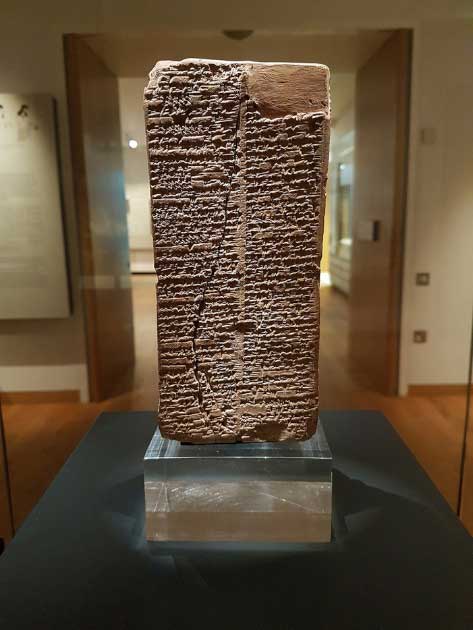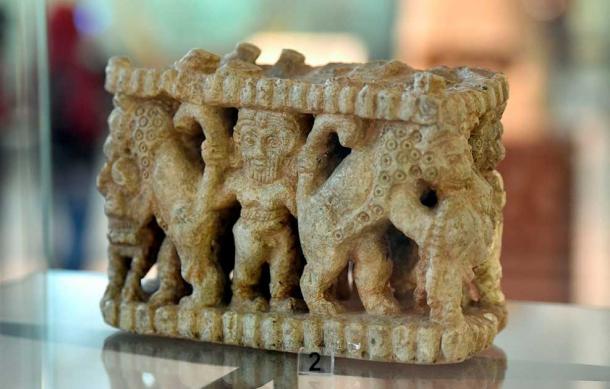
The Sumerian King List Reveals the Origin of Mesopotamian Kingship
Out of the many incredible artifacts that have been recovered from sites in Iraq where flourishing Sumerian cities once stood, few have been more intriguing than the Sumerian King List. An ancient manuscript originally recorded in the Sumerian language, the Sumerian King List is a register of the kings of Sumer (ancient southern Iraq) from Sumerian and neighboring dynasties.
The list includes their names, supposed reign lengths, and the locations of “official” kingship. What makes the Sumerian King List so unique is the fact that it blends apparently mythical pre-dynastic rulers with historical rulers who are known to have existed in real life.
- Translating Archaic Sumerian Cuneiform: Pinpointing Eden, or Kharsag, Garden of the Gods
- The Kesh Temple Hymn: 4,600-Year-Old Sumerian Hymn Praises Enlil, Ruler of Gods
The first fragment of this rare and unique text, a 4,000-year-old cuneiform tablet, was found in the early 1900s by German-American scholar Hermann Hilprecht at the site of ancient Nippur and his results were published in 1906. Since Hilprecht’s discovery, at least 18 other exemplars of the king’s list have been found, most of them dating from the second half of the Isin Dynasty (c. 2017 to 1794 BC).
No two of these documents are identical. However, there is enough common material in all versions of the Sumerian King List to make it clear that they are derived from a single, “ideal” account of Sumerian history.

The Weld-Blundell Prism. (Ashmolean Museum / CC BY-SA 4.0)
The Weld-Blundell Prism
Among all the examples of the Sumerian King List, the Weld-Blundell prism in the Ashmolean Museum cuneiform collection in Oxford represents the most extensive version, as well as the most complete copy of the Sumerian King List. The 8-inch-high (20.32 cm) prism contains four sides with two columns on each side.
It is believed that the Weld-Blundell prism originally had a wooden spindle going through its center so that it could be rotated and read on all four sides. It lists rulers from the antediluvian (“before the flood”) dynasties to the fourteenth ruler of the Isin Dynasty (ca. 1763 to 1753 BC).
The list is of immense value because it reflects very old traditions while at the same time providing an important chronological framework relating to the different periods of kingship in Sumeria. It even demonstrates remarkable parallels to accounts in Genesis.
The Ancient Civilization of Sumer
Sumer (sometimes called Sumeria), is the site of the earliest known civilization, located in the southernmost part of Mesopotamia between the Tigris and the Euphrates rivers, in the area that later became Babylonia and is now southern Iraq from around Baghdad to the Persian Gulf.
By the 3rd millennium BC, Sumer was the site of at least twelve separate city states, including Kish, Erech, Ur, Sippar, Akshak, Larak, Nippur, Adab, Umma, Lagash, Bad-tibira and Larsa. Each of these states comprised a walled city and its surrounding villages and land. Each city state worshiped its own deity, whose temple was the central structure of the city.
Political power originally belonged to the citizens, but, as rivalry between the various city states increased, each adopted the institution of kingship. The Sumerian King List records that eight kings reigned before a Great Flood. Afterwards, the list claims that various city-states and their dynasties of kings temporarily gained power over the others.

Sculptured vase depicting Gilgamesh wrestling two bulls from the Shara temple at Tell Agrab, Diyala Region, Iraq. Gilgamesh was included in the Sumerian King List. (Osama Shukir Muhammed Amin / CC BY-SA 4.0)
Sumer’s Mythical Past: Mythical Figures in the Sumerian King List
The Sumerian King List begins with the very origin of kingship, which is seen as a divine institution: “the kingship had descended from heaven.” The rulers in the earliest dynasties are represented as reigning fantastically long periods:
After the kingship descended from heaven, the kingship was in Eridug. In Eridug, Alulim became king; he ruled for 28800 years. Alaljar ruled for 36000 years. 2 kings; they ruled for 64800 years.
Some of the rulers mentioned in the early list, such as Etana, Lugal-banda and Gilgamesh, are mythical or legendary figures whose heroic feats are subjects of a series of Sumerian and Babylonian narrative compositions.
The early list names eight kings with a total of 241,200 years from the time when kingship “descended from heaven” to the time when “the Flood” swept over the land and once more “the kingship was lowered from heaven” after the Flood.
Interpretation of the Long Tenures of Early Kings
The amazingly long tenure of the early kings has provoked many attempts at interpretation. At one extreme is the complete dismissal of the astronomically large figures as “completely artificial” and the view that they are unworthy of serious consideration. At the other extreme, is the belief that the numbers have a basis in reality and that the early kings were indeed gods who were capable of living much longer than humans.
In between the two extremes is the hypothesis that the figures represent relative power, triumph or importance. For example, in ancient Egypt, the phrase “he died aged 110” referred to someone who lived life to the full and who offered an important contribution to society.
In the same way, the extremely reigns of the early kings may represent how incredibly important they were perceived as being in the eyes of the people. This doesn’t explain, however, why the periods of tenure later switched to realistic time periods.
Related to this perspective is the belief that although the early kings are historically unattested, this does not preclude their possible correspondence with historical rulers who were later mythicized. Some scholars, such as Harrison, have even sought to explain the figures through mathematical investigation and interpretation.

Painting of the Great Flood as told in Genesis. Augsburger Wunderzeichenbuch, Folio 1 (Genesis 7, 11-14). (Public domain)
The Sumerian King List and its Relation to Genesis
Some scholars (e.g. Bryant G. Wood, 2003) have drawn attention to the fact that there are remarkable similarities between the Sumerian King List and accounts in Genesis. For example, Genesis tells the story of ‘the great flood’ and Noah’s efforts to save all the species of animals on Earth from destruction. Likewise, in the Sumerian King List there is discussion of a great deluge, where the text states that “the flood swept over the earth.”
The Sumerian King List provides a list of eight kings (some versions have 10) who reigned for long periods of time before the flood, ranging from 18,600 to 43,200 years. This is similar to Genesis 5, where the generations from Creation to the Flood are recorded. Interestingly, between Adam and Noah there are eight generations, just as there are eight kings between the beginning of kingship and the flood in the Sumerian King List.
- Ancient Babylonian Reborn After Having Been Silenced for 2000 Years
- The Code of Ur-Nammu: When Ancient Sumerians Laid Down the Law, Everyone Obeyed
After the flood, the King List records kings who ruled for much shorter periods of time. Thus, the Sumerian King List not only documents a great flood early in man’s history, but it also reflects the same pattern of decreasing longevity as found in the Bible - men had extremely long life spans before the flood and much shorter life spans following the flood.
The Sumerian King List truly is a perplexing mystery. Why would the Sumerians combine mythical rulers with actual historical rulers in one document? Why are there so many similarities with Genesis? Why were ancient kings described as ruling for thousands of years? These are just some of the questions that still remain unanswered after more than a century of research.
Top image: Weld-Blundell Prism, a clay cuneiform inscribed with the Sumerian Kings List. Source: Public domain
By Joanna Gillan
References
Geerts, L. C. No date. “The Sumerian King List” in Biblioteca Pleyades. Available at: https://www.bibliotecapleyades.net/sitchin/king_list.htm
Harrison, R. K. 1993. “Reinvestigating the Antediluvian Sumerian King List” in JETS 36/I. Available at: https://www.etsjets.org/files/JETS-PDFs/36/36-1/JETS_36-1_003-008_Harrison.pdf
Jacobsen, T. 1939. The Sumerian King List. The Oriental Institute of the University of Chicago. The University of Chicago Press. Available at: http://oi.uchicago.edu/pdf/as11.pdf
No name. No date. “The Sumerian King List (SKL)” in A Library of Knowledge of the Cuneiform Digital Library Initiative. Available at: https://cdli.ox.ac.uk/wiki/doku.php?id=the_sumerian_king_list_skl
No name. No date. “The Sumerian king list: translation” in The Electronic Text Corpus of Sumerian Literature. Available at: https://etcsl.orinst.ox.ac.uk/section2/tr211.htm
Wood, B. G. 2003. “Great Discoveries in Biblical Archaeology: The Sumerian King List” in Bible and Space Journal. Available at: https://www.galaxie.com/article/bspade16-4-04
















Comments
I highly recommend that people take some time and read the Ethiopian Book of Enoch as well as his Book of Secrets. I am a believer in Christ and a mathematician and have studied the scriptures since 1965. The Niacin Counsel should have never rejected it, in my humble opinion. Due to closed minded people in our own churches, they have no idea how to explain the first six “Days” of creation ….. unless you are a mathematician. Dark Energy set the universe in motion and shows us, through the shift in light, that this universe is expanding. Dark Matter (clear gravity) binds the universe together and is its backbone. Surround it all with Antimatter and you have yourself your own universe. Welcome to Genesis 1:2, the scientific version. God's Holy Spirit makes up 95% of the mass of this universe and it literally slows things down on purpose. If time was any faster, nothing would bind together. If time was slower, we would have already existed. If you want to know what I call “True Time”, just divide 186,000 MPS by 5% and then do the math. Welcome to a Day of Creation.
If you are a pastor of a church, reach out to me, if you want. I miss Albert Einstein …..
Consider alternatives. Mistranslation. Fakes. Lack of a sense of humour.
There are beings who are eternal, but their bodies are not like ours are. They have physical doubles on Earth, on occasion, that you might meet, on occasion. In Europe there is the Count St. Germain who may still be around, and Jesus who according to Revelation is now immortal: “and behold I am alive for evermore.!”
Whether the translations are truthful and the figures therefore correct matters less than logic, and early on in this article, for example, we find the statement: “What makes this artefact so unique is the fact that the list blends apparently mythical pre-dynastic rulers with historical rulers who are known to have existed.”
Really? We have neither evidence nor proof that ANY of these people ever existed at all, just a few stones with writing on them neither of which can be dated. And, to be pedantic “so unique” cannot exist as unique is unique, and cannot be more so!
If you will remember just how many RKOlogical fakes there are, and just how easy it is to fool us with stone tablets etc. a profound forensic examination of this sculpture might not go amiss.
Piltdown man was cobbled together by some very well-known people- all far better known than the obscure guy who “found” this stone, and it was discovered to be a fake as skeletons and skulls are much more difficult to create, whereas stone is eternal, and can live for, ooh, at least 64,800 years, to name but a few.
Where did the numbers come from? And was the idea of 8 kings lifted from a book Hilprecht knew: the Bible?
For all we know there was a thriving cottage industry in the area churning these things out for us westerners, just as there is now in Egypt!!
The ‘mythical’ kings are included because the people who made the list weren’t alive before the flood, and likely were relying on embellished/fragmented tales. It also might have been dynastic propaganda, if the king in question was supposedly related to a mythic figure.
If Sitchin’s translations are correct, they were from a different planet, and they might well have lived for such lengths of time. I don’t understand why there are so many instances of “scholars” not taking the ancient histories at face value. For instance, the insistence that the Inca built those walls outside Cusco, even though early Spanish conquerers reported that the Inca told them they were there long before. The Smithsonian excavated and/or bought skeletons of giants, but now deny their existence. I thought education was supposed to open minds, not put up blinders
the numbers are astrological estimations of the length of time the sun is in each constellation using the precession as markers. they were aware of the nutation coded their mythical beliefs in the sky above as did the mayans, and the egyptians and greeks and romans and Hebrews.
Pages